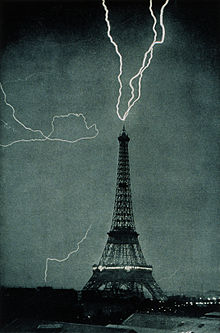
Back صاعقة Arabic Lliju lliju Aymara برخورد صاعقه Persian 恨雷 GAN Walƙiya mai haɗari Hausa מכת ברק HE Serangan petir ID 落雷 Japanese 낙뢰 Korean Trăsnet Romanian


A lightning strike or lightning bolt is a lightning event in which an electric discharge takes place between the atmosphere and the ground. Most originate in a cumulonimbus cloud and terminate on the ground, called cloud-to-ground (CG) lightning. A less common type of strike, ground-to-cloud (GC) lightning, is upward-propagating lightning initiated from a tall grounded object and reaching into the clouds. About 25% of all lightning events worldwide are strikes between the atmosphere and earth-bound objects. Most are intracloud (IC) lightning and cloud-to-cloud (CC), where discharges only occur high in the atmosphere.[1][2] Lightning strikes the average commercial aircraft at least once a year, but modern engineering and design means this is rarely a problem. The movement of aircraft through clouds can even cause lightning strikes.[3]
A single lightning event is a "flash", which is a complex, multistage process, some parts of which are not fully understood. Most CG flashes only "strike" one physical location, referred to as a "termination". The primary conducting channel, the bright, coursing light that may be seen and is called a "strike", is only about one inch (ca. 2.5 cm) in diameter, but because of its extreme brilliance, it often looks much larger to the human eye and in photographs. Lightning discharges are typically miles long, but certain types of horizontal discharges can be tens of miles in length. The entire flash lasts only a fraction of a second.[citation needed]
- ^ Cooray, Vernon. (2014). Lightning Flash (2nd Edition) - 1. Charge Structure and Geographical Variation of Thunderclouds. Page 4. Institution of Engineering and Technology.
- ^ "GHRC: Lightning Characteristics". Archived from the original on 2016-03-05.
- ^ Edward J. Rupke (August 14, 2006). "What happens when lightning strikes an airplane?". Scientific American. Retrieved 2023-08-23.